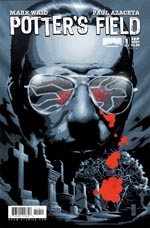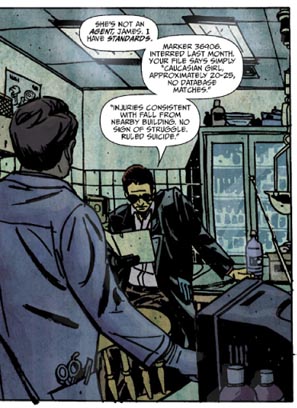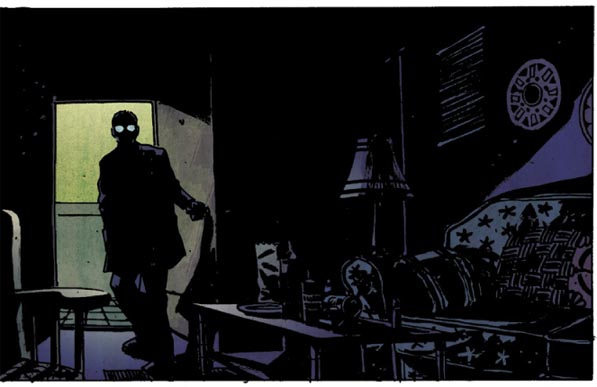 Written by Mark Waid
Written by Mark Waid
Art by Paul Azaceta
32 pages, color
Published by Boom! Studios
There’s an old adage that there are only a limited number of plots in the world, and that every story is just a slight variation on those ideas. (Some people claim the actual number is three, others go for seven. The fact that there’s no clear consensus on the number of actual plots says a lot in its own right.) But on a similar level, I think it is fair to say that just as two stories with the same “plot” can be radically different, so can different stories with the same basic set-up. So when I say that Mark Waid and Paul Azaceta’s Potter’s Field reminds me of Andy Helfer, Bill Sienkiewicz, and Kyle Baker’s run on The Shadow from the mid-80s, I’m not claiming that Waid and Azaceta are stealing or ripping off The Shadow. Rather, that it’s a familiar set-up that will certainly make fans of the old book a little nostalgic and probably very happy.
Potter’s Field is where the unknown bodies are buried in a cemetery; nameless, unclaimed, the only record of their life is an assigned number engraved on an otherwise blank stone marker. That’s where John Doe comes in. No one knows who he is or why he tirelessly struggles to discover the real identity of each person buried in the City of New York’s Potter’s Field. With his network of agents assisting him—some willingly, others not so much—John Doe will put the mystery of their lives and deaths to rest, one at a time.
 One of the things that grabbed my attention so much with the Helfer version of The Shadow (and originally set up by Howard Chaykin’s earlier mini-series) was the idea that this was a mysterious man who had a wide array of agents assisting him, from police officers and pharmacists to high school teachers and food critics. With The Shadow, though, in many ways the group was one big happy family that over time all knew each other and got along. With Potter’s Field, Waid uses the same structure but in a much more interesting and logical way; John Doe’s agents not only don’t know each other, they don’t even know who John Doe really is. I love the element of distrust that Doe and his agents have, because it increases the level of mystery about him. It makes him seem that much more enigmatic; discovering that he doesn’t leave fingerprints behind is so-so, but learning that because one of his assistants is dusting for them to try and find out who Doe is? Now that’s a much more intriguing fact to me.
One of the things that grabbed my attention so much with the Helfer version of The Shadow (and originally set up by Howard Chaykin’s earlier mini-series) was the idea that this was a mysterious man who had a wide array of agents assisting him, from police officers and pharmacists to high school teachers and food critics. With The Shadow, though, in many ways the group was one big happy family that over time all knew each other and got along. With Potter’s Field, Waid uses the same structure but in a much more interesting and logical way; John Doe’s agents not only don’t know each other, they don’t even know who John Doe really is. I love the element of distrust that Doe and his agents have, because it increases the level of mystery about him. It makes him seem that much more enigmatic; discovering that he doesn’t leave fingerprints behind is so-so, but learning that because one of his assistants is dusting for them to try and find out who Doe is? Now that’s a much more intriguing fact to me.
As an introductory, self-contained story, Potter’s Field #1 does everything right to make you want to read more. You see how Doe works, the case of a young girl’s death is solved, and everything is tied up in a neat bow—aside from the last-page lead-in to the next issue, of course. It’s a smart move, because you get a strong feel for what this comic is about, and while there’s a good hook for the next installment, at the same time you never feel like Waid is stringing you along; you get your money’s worth in the first issue and a complete reading experience. It’s concise storytelling, something that is missing far too often in comics these days.
I don’t recall seeing Azaceta’s art before, but it’s a sharp finished product. Along with colorist Nick Filardi they create a look that reminds me of painted sequential art along the lines of Tommy Lee Edwards or John Van Fleet; strong but not over-rendered ink lines, while remaining rich in background detail. Every scene, be it a cemetery, a street corner, or an empty apartment, is carefully designed and fleshed out to look real. It really helps place Potter’s Field in the real world, making it feel like somewhere you’ve been or seen in the past. Azaceta’s panel composition is also sharp; from shadows falling across John Doe’s body as he enters a darkened room, to Doe leaning up against a table in a coroner’s office, everything feels natural and at the same time draws the reader’s eye to the center of the scene, keeping the right elements at the forefront. If Azaceta doesn’t have companies knocking on his door offering him work, he certainly will once they see Potter’s Field.

It wasn’t until I was re-reading the issue to write the review that I noticed that Potter’s Field is scheduled to be a three-issue mini-series. Now while it may turn out that Waid already has an ending plotted out, I hope that this is more a case of testing the waters. There’s an endless amount of story potential in this comic, and I for one would cheerfully buy comics of this quality every month. This is definitely one of Waid’s strongest books in years, and hopefully it’s just the start of a lot more to come. Highly recommended.
